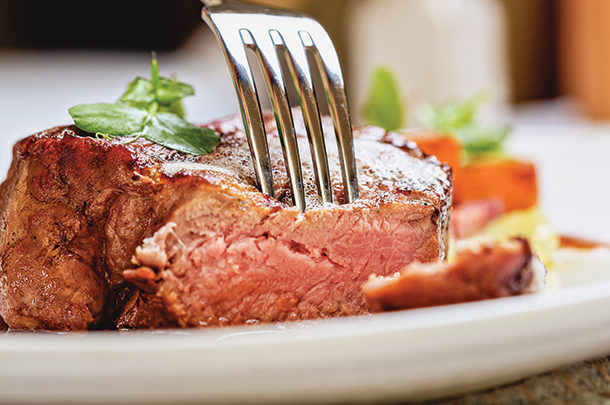Quality assurance programs are all too familiar across the beef industry. Typically, these programs are discussed at the food product plants where we are working to maintain the quality of product after the animal is harvested. However, what about before the animal is harvested? Does how we raise and handle the animal before harvest affect the quality of the beef? Yes.
What can we do as producers to ensure we are doing our part in producing the highest-quality beef product? Part of the answer is as simple as adopting the Beef Checkoff-funded Beef Quality Assurance (BQA) program’s principles and guidelines on our operations.
If you do not know much about BQA, let me give you a little history behind the program. In the early 1970s and ’80s, cattle producers who were using injectable animal health products were not concerned about meeting withdrawal times, which led to violative residues. Not only this, but injection-site lesions also plagued the beef industry. Cattle producers became concerned about governmental regulation within the cattle industry and began investigating ways to ensure safe production practices. Working alongside the USDA Food Safety Inspection Service (FSIS), the beef industry developed a pre-harvest safety production program. This program became the backbone for today’s BQA program.
Today, the BQA program is a voluntary producer-driven program based on hazard analysis critical control point (HACCP) principles centered on recommended national guidelines and research. It is a nationally coordinated, state-implemented program that provides systematic information to beef producers of science-based, common sense husbandry techniques that can be used to responsibly raise cattle. The mission of BQA is to maximize consumer confidence in and acceptance of beef by focusing the producer’s attention to daily production practices that influence the safety, wholesomeness and quality of beef and beef products.
An extension of the BQA program is Beef Quality Assurance Transportation (BQAT). This program is aimed at educating cattle haulers on the importance of their role in the beef industry and how their actions when handling and transporting cattle can influence animal welfare and beef product quality.
Milestones along the way
So what exactly has the BQA program accomplished for the industry? To answer this question, we need to look at data from past National Beef Quality Audits (NBQA), past injection-site frequency research and past consumer market research.
The BQA program has made great strides in the reduction of violative residues and injection-site lesions observed at beef packing plants. This is due to educating producers on proper record-keeping practices that prevent the marketing of animals which have not yet cleared withdrawal periods, and injection placement while administering injectables when treating cattle.
Research investigating the frequency of injection-site lesions in beef packing plants showed a 22.3% incidence rate for fed cattle carcasses in 1991. The most recent study in 2000 showed the incidence rate had dropped to less than 3% for fed cattle. However, there is still more work to be done in the market cow and bull sector. In a 2016 research project investigating the frequency of injection-site lesions in muscles from rounds of dairy and beef cow and bull carcasses, researchers observed a 15% (dairy) and 7% (beef) presence of injection-site lesions.
The beef industry has also experienced a decline in the presence of critical and extreme carcass bruising. Critical A carcass bruise – where 10 pounds up to the weight of the entire wholesale primal of trim is removed – is considered critical, and a carcass bruise that requires the entire wholesale primal to be discarded due to the bruising is considered extreme.
In the early 1990s, entire beef carcasses were being condemned and rendered due to the amount of bruising present on the carcass. In the most recent 2016 NBQA, the presence of critical and extreme bruising was below 2% and 1%, respectively. This decline of critical and extreme carcass bruising in the beef industry can be attributed to the BQA program’s new focus on educating producers about low-stress cattle handling and proper stockmanship principles.
These are just two examples of how the BQA program has worked to resolve issues that have, and continue to have, a financial impact on the beef industry. It is estimated that, in 2016, carcass bruising cost the fed cattle industry over $62 million, and injection-site lesions cost another $2.42 million. Through the implementation of BQA guidelines and good stockmanship principles on their operations, cattle producers are doing their part to reduce these previously mentioned negative financial impacts on the industry. It also demonstrates their commitment to providing a safe, high-quality, wholesome product to beef consumers, which leads me to my next point on how BQA can be used to protect and increase consumer confidence when purchasing beef.
In order to meet and exceed consumer expectations, we must have two things, product integrity and a high-quality product that meets the eating expectation of the consumer. Past Beef Checkoff-funded consumer market research has shown that 68% of consumers make purchasing decisions based on animal welfare practices, yet only 24% of consumers claim to be knowledgeable on how cattle are raised for food.
Other market research has shown that 61% of consumers mentioned a concern when it comes to food animal production practices and that animal welfare is their number one concern. In one survey prior to being exposed to the BQA program, consumers were asked about their perceptions of how cattle were raised for food. Five percent of consumers responded strongly negative, while 20% felt strongly positive. However, after these same consumers were exposed to the BQA program, the percentage who felt strongly negative dropped to 2%, and the strongly positive group increased to 30%. This consumer research is just a testament to how the BQA program has a positive impact on the beef-purchasing consumer.
Participation in BQA and BQAT helps the everyday beef producer or hauler tell the story of how animal welfare is top-of-mind when raising and transporting cattle. A producer or cattle hauler who follows and practices BQA and BQAT principles demonstrates their commitment to beef safety and quality, safeguarding the public image of the beef industry, maintaining consumer confidence in beef and protecting the industry from governmental regulation.
A cow-calf producer from the 2016 NBQA Strategy Workshop said it best, “It doesn’t matter how superior of a product we are producing if the consumers don’t purchase it.” This requires all parties involved in the beef industry working together to ensure and protect consumer confidence in beef and beef products. To do this, it all starts with how the animals used to produce these products are raised and cared for throughout the entire life cycle. Currently, the program influences the management of more than 80% of U.S. cattle, helping ensure that farmers and ranchers are taking the best possible care of their animals.
BQA and BQAT certification is offered through in-person and online training. To learn more about becoming BQA or BQAT certified, visit BQA.org.











